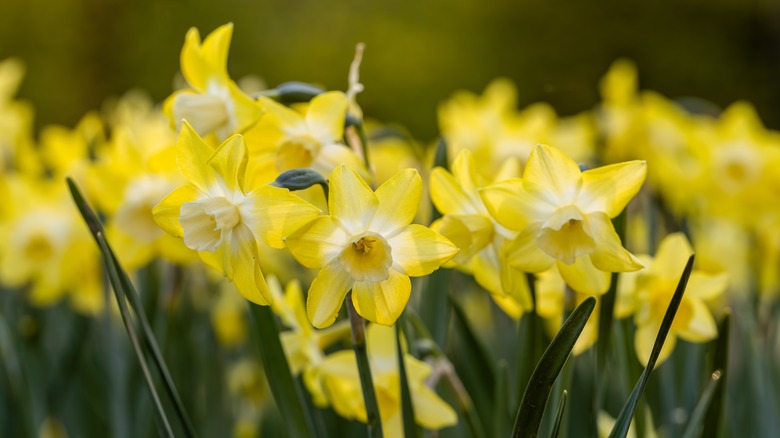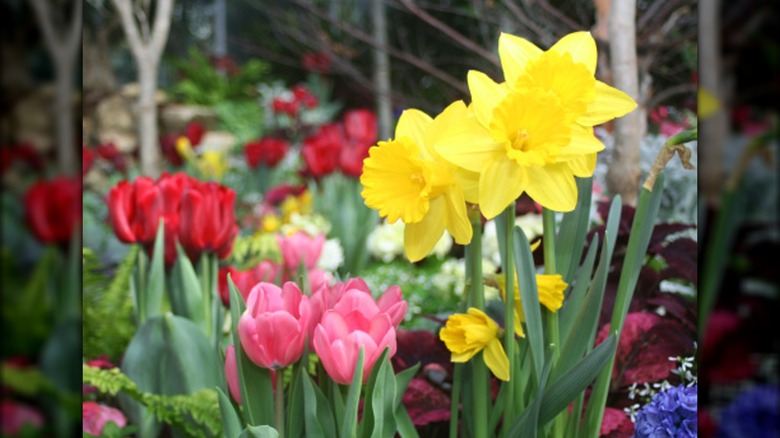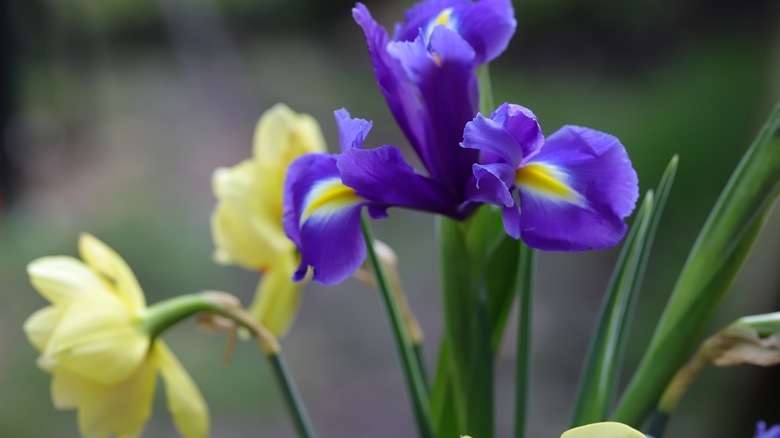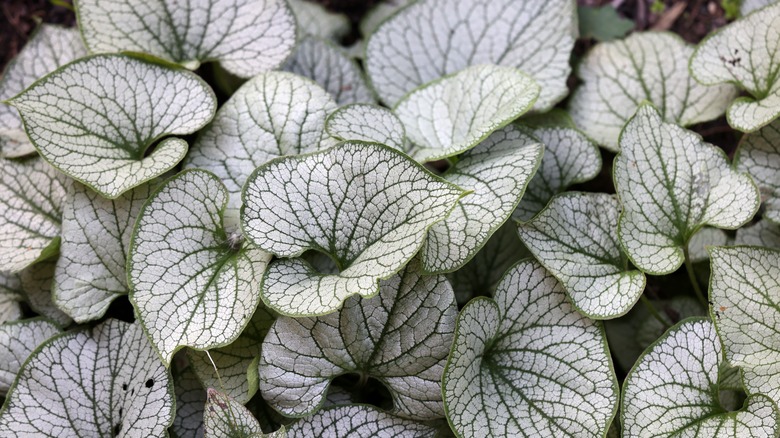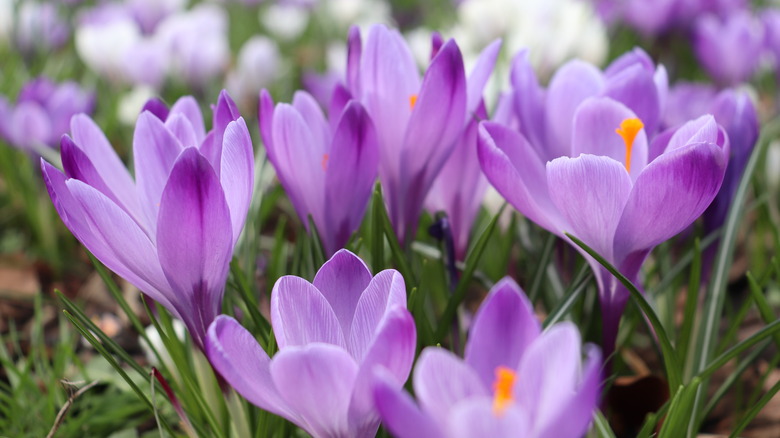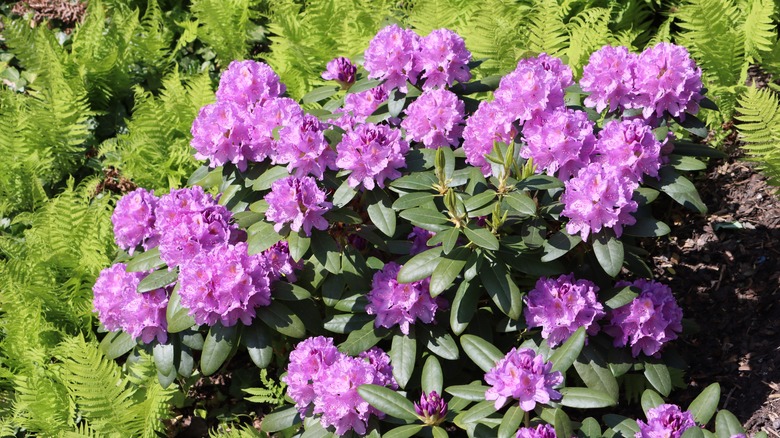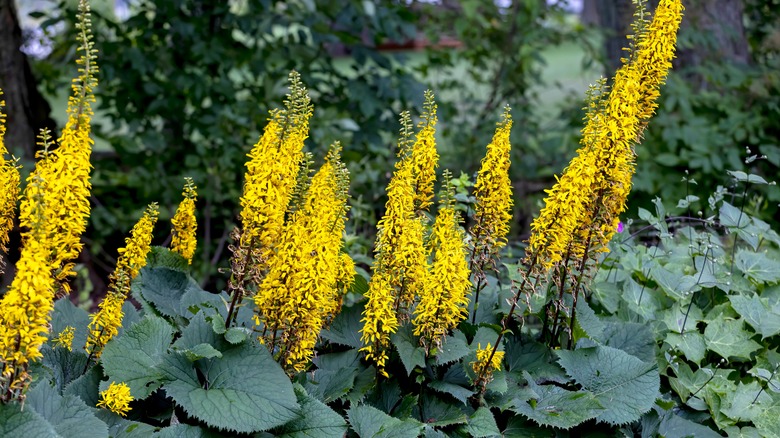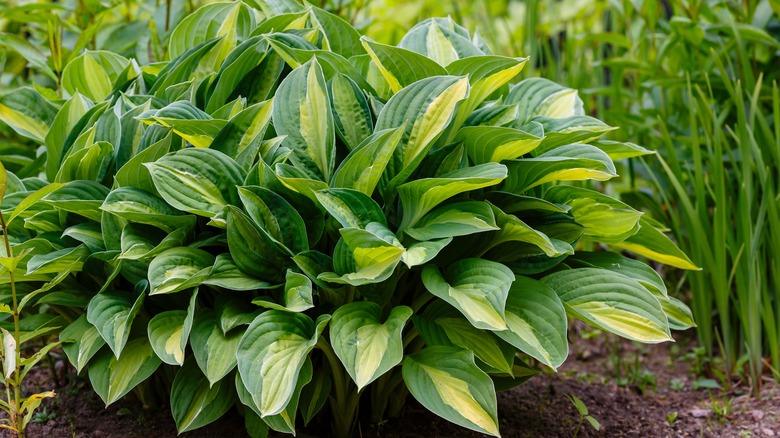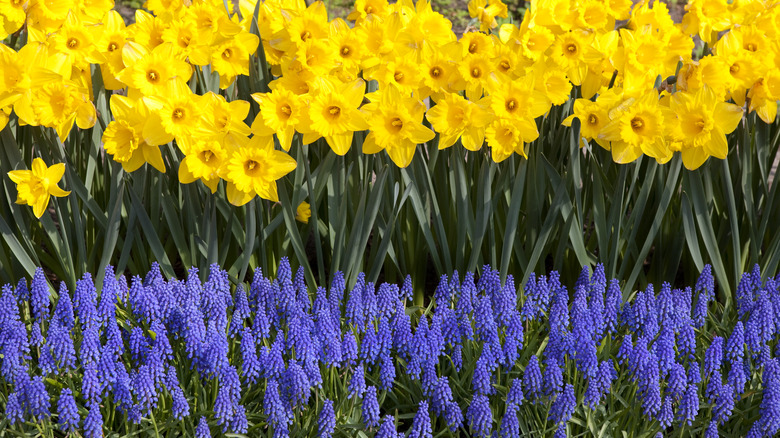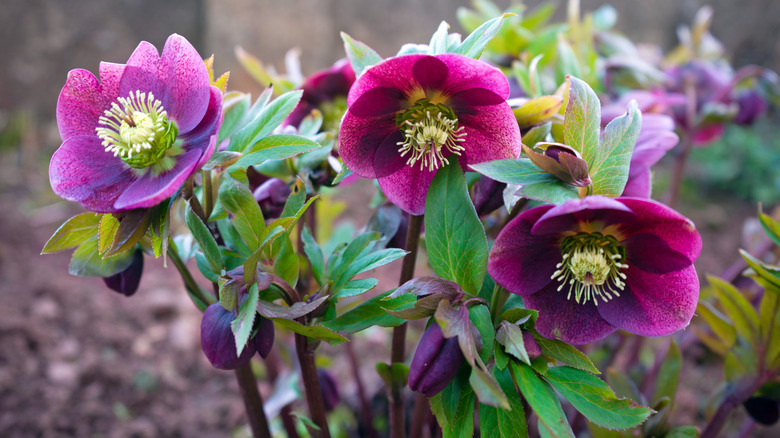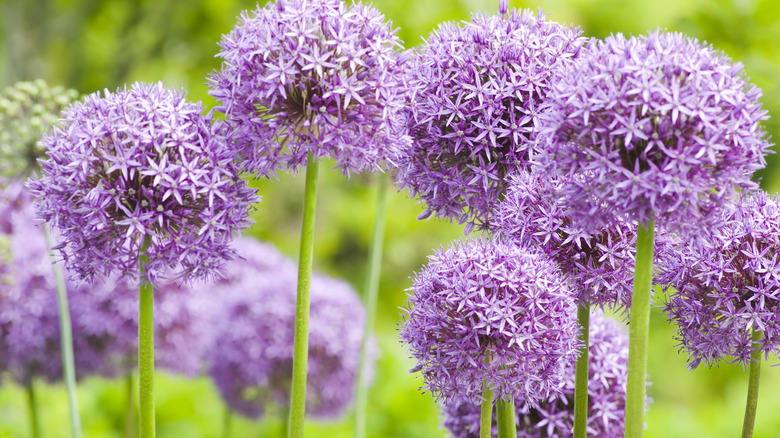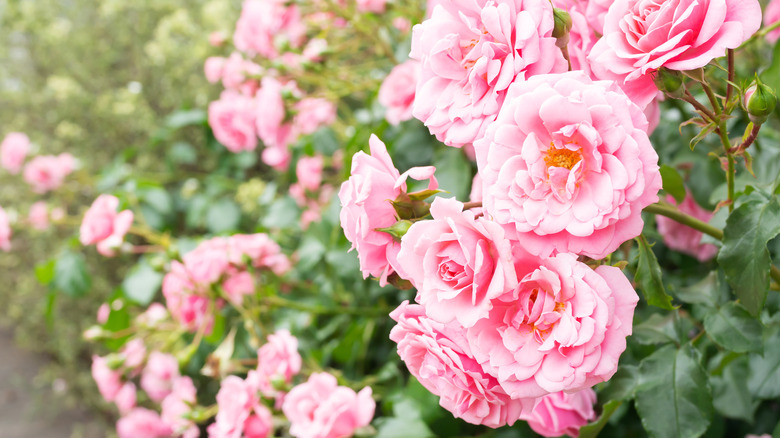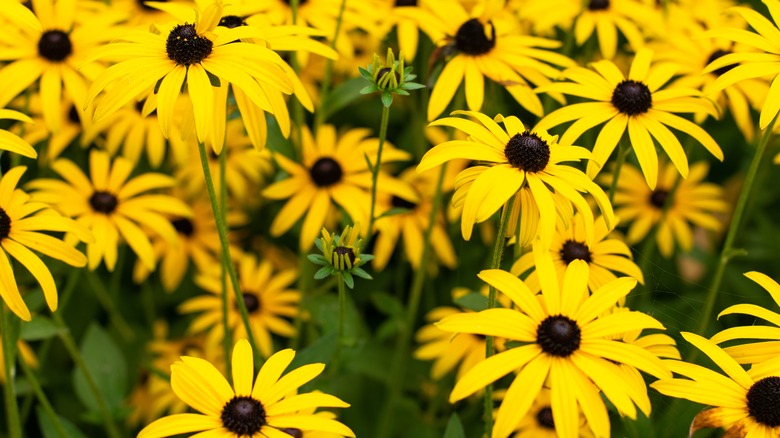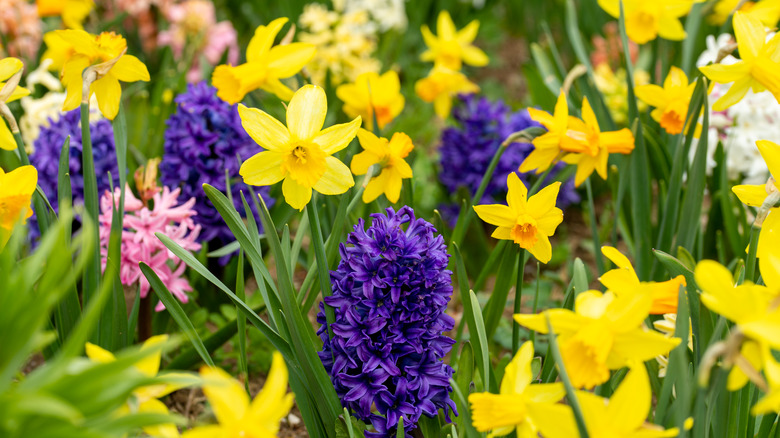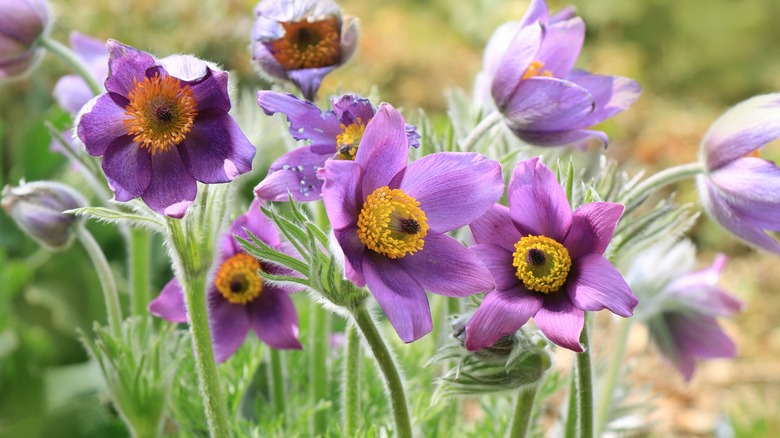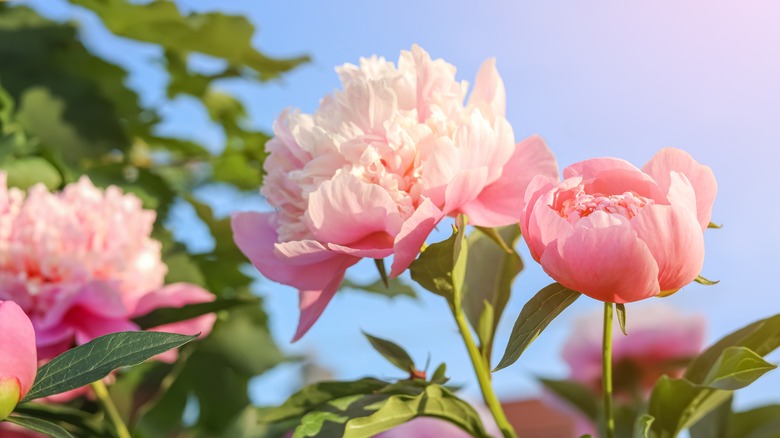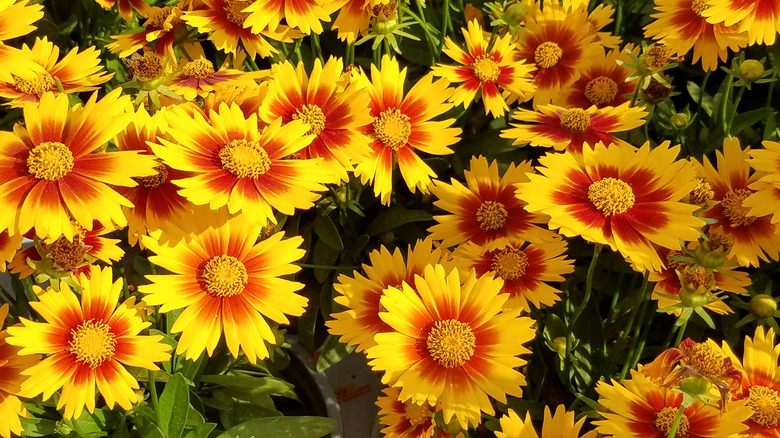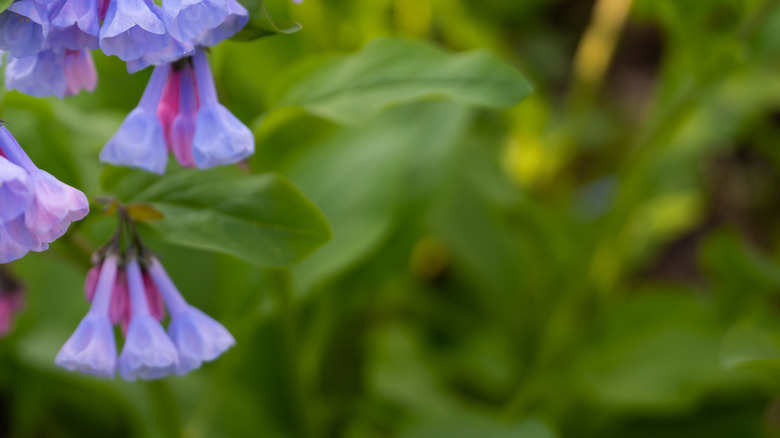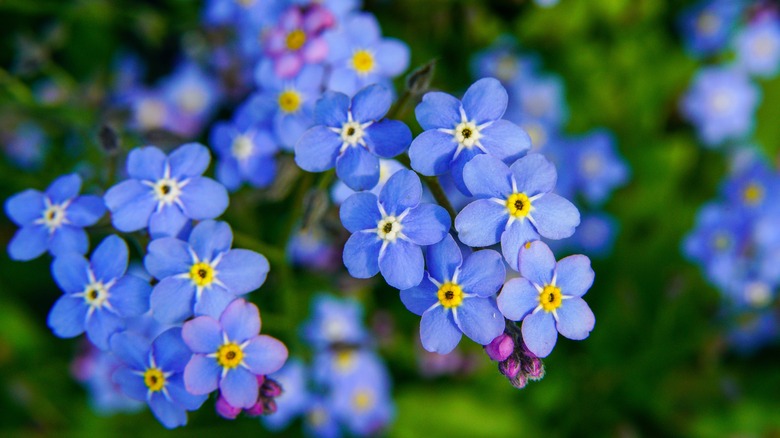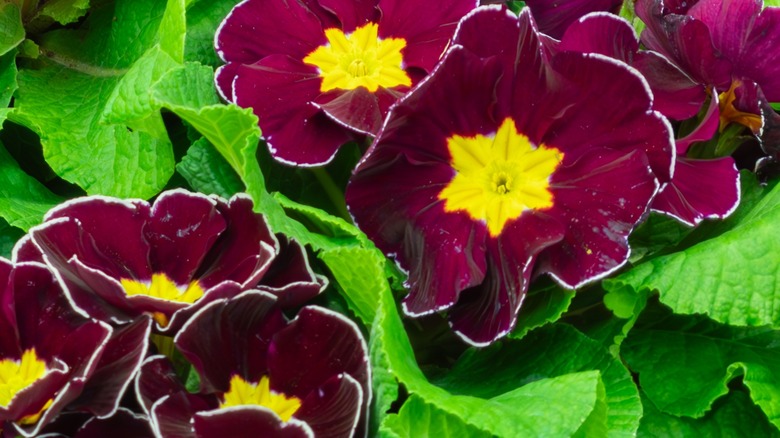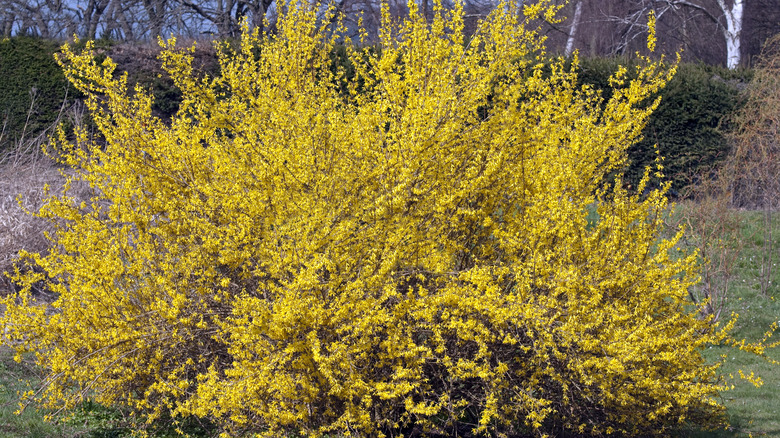20 Plants That Look The Best Next To Daffodils In The Garden
With vibrant yellow petals that bloom each year, many gardeners love daffodils as a feature of their gardens. You don't need to know everything about growing daffodils to learn what flowers they pair well with and help them thrive and grow, which is the basic idea of companion planting. While companion planting can help prevent pests and diseases, daffodils don't have many to deal with in the first place. Companion plants for daffodils are often chosen for aesthetic reasons because their colors pair well together or their shapes complement each other.
Since daffodils are one of the earliest bloomers, they also tend to wilt earlier than other flowers. That means you may want to choose flowers that may bloom after or for longer, so your daffodils dying back won't leave your yard bare. Similarly, you may choose flowers that bloom after daffodils so that when the daffodils have completed their season, there is a new crop of flowers, allowing your garden to have a color and blooms throughout the other seasons. This can ensure a garden that's aesthetically pleasing and always in bloom.
Of course, you'll also want to consider the growing conditions of the companion plants. Daffodils are perennials, so they grow back each year. You may want to consider planting other perennial bulbs so you have reliable flowers and don't have to disturb the bulbs during their growing phase. You also want flowers and plants that have similar light and water requirements so both are happy while growing.
1. Tulips
Tulips (Tulipa spp.) are another garden favorite and work especially well as a companion plant to daffodils. They're both hardy and cold-tolerant, so even if they bloom early, they won't die off quickly in your garden. Coming in a variety of colors, you'll have plenty of options to customize a flower color scheme. Stick with a monochrome yellow, or play around with warm tones by adding orange and red. Tulips also bloom in purples, pinks, white, and multicolor, so the combinations are endless. These and daffodils can be planted around the same time, ideal for a low-key flower combination.
2. Irises
Statuesque and whimsical irises (Iris versicolor) are one of the best choices to add color to a spring garden. These flowers come in nearly every color of the rainbow, including yellow, pink, blue, and purple, so that you can create a custom color scheme mixing daffodils and irises together. These flowers prefer full or partial sun to grow their showy blooms. Daffodils and irises can bloom at the same time, but irises can continue to bloom a little longer. You want to be sure to choose iris varieties that aren't too tall that they block out the sun for daffodils.
3. Heartleaf Brunnera
Add some greenery to your garden with Brunnera (Brunnera macrophylla). This ground cover is a perennial with showy, heart-shaped leaves that grow little purple-blue flowers in April and May. Because it's a ground cover, it grows low, which can provide a lush base for daffodils. It's an easy-going plant that will look great throughout the year, creating a beautiful surrounding for daffodils and stunning foliage even after they die back. It requires moist soil and partial to full shade. Brunnera looks great growing next to your spring bulbs, so scatter daffodils throughout for pops of color.
4. Crocus
Crocuses (Crocus spp.) can sometimes be mistaken for tulips for their similar appearance. However, they're smaller, growing between 2 and 4 inches tall. Fall is the best time of year to plant crocus for them to bloom in spring along with daffodils. Both are perennials, which makes them ideal companions to each other. The variety of colors — from blue and purple to orange and yellow — also makes them a good pair for daffodils and those seeking a garden full of color. They like full to partial sun, but be careful not to let daffodils block the crocuses' sunlight.
5. Rhododendron
Rhododendrons (Rhododendron spp.) are a flowering shrub that pairs well with daffodils. They bloom in the spring and summer, usually after daffodils start to die off. Planting rhododendrons, or azaleas, with spring bulbs like daffodils will give you continuous color. And since rhododendron shrubs are larger, they'll take the attention away from wilted daffodils. When they're not in bloom, they offer simple greenery that will provide a nice backdrop to blooming daffodils. Rhododendrons come in yellow, white, pink, purple, and red and prefer to be planted where they receive part sun and part shade.
6. Ligularia
Ligularia (Ligularia spp.) is the perfect flower to add some visual interest to your garden. Bright yellow blooms that grow in long spikes are sure to be an attention-grabber. They have large, showy foliage providing a lush backdrop for daffodils in the spring, then bloom in the summer to continue the vibrant yellow color. They can be planted in the fall along with daffodils to have an established plant by spring. Grow in partial shade and use it as an edge plant. Daffodils can take on a little sun and grow in front of ligularia.
7. Hosta
Hostas (Hosta spp.) are a common plant to add foliage to a garden. Their large leaves look great with blooming daffodils in the spring. Plant daffodils in front of or between hostas to help fill out a garden. Because they can grow between 1 foot and 3 feet tall, hostas are also able to conceal daffodil leaves and stems once they begin to die back. Hostas will also bloom with pink, blue, lavender, or white flowers in the summer after daffodils have finished blooming. They prefer partial shade and shadier areas of the garden and make great edging plants.
8. Muscari
Muscari armeniacum, known as grape hyacinths, are small, clustered flowers that often pop up around spring. Bulbs can be planted along with tulips in fall, and both are perennials, so they'll bring color to your garden for years to come. Grape hyacinths, with their tight cluster of bell-shaped petals, will bring a unique texture to your garden when planted among daffodils. There are blue, violet, and pink varieties that will complement the colors of daffodils well. Grape hyacinths prefer sun to partial shade, similar to daffodils, so they're a great companion.
9. Hellebore
Want flowers in your garden year-round? Hellebore (Helleborus spp.) is the answer. This flower blooms between Christmas and Easter, which makes it a different choice for a daffodil companion plant. Though they'll have just a little time overlapping, they'll pick up where the other left off, so your garden will be in constant boom. They have showy blooms that are white, pink, burgundy, and black, so they can add an interesting color scheme to a garden. They can be used as border plants and enjoy partial shade. Plant amongst each other to create an interesting texture.
10. Allium
Alliums are one of the most unique flowers you can grow in your garden. With tall stocks that bloom small purple, pink, or white pom-pom-like clusters, they're a great option to add texture to a garden. They bloom in spring, allowing them to bloom alongside daffodils. Their bulbs can also be planted in the fall alongside daffodils. The smallest variety can grow between 3 and 6 inches tall, while the tallest varieties can grow between 12 and 18 inches tall. They like the sun, so they'll pair well with daffodils to add some interest and height.
11. Roses
Roses (rosa spp.) need no introduction for flower lovers and gardeners. They're classic and elegant, great for adding color and texture. They bloom in late spring and throughout the summer and prefer full to partial sun. Planting roses with daffodils provides them with more protection from pests and diseases and can help extend their season. Daffodils will fill in the gaps between roses as they grow together. With the wide variety of roses and color options, you can create a custom color scheme in the garden. Though these two flowers won't always bloom together, they have a mutually beneficial relationship.
12. Black-eyed Susan
Black-eyed Susans (Rudbeckia spp.) are one of the signs of summer. These daisy-like yellow flowers will begin to bloom when daffodils die off. They bloom from June to August, allowing you to have a vibrant yellow flower in your garden almost year-round, or orange and red if you prefer that variety. They bloom best in full and partial sun, so they can be planted around daffodils in the fall. Black-eyed Susans can be annuals, biennials, or perennials. It may be best to choose perennial varieties to avoid disturbing daffodil bulbs when planting.
13. Hyacinth
Another common mark of spring is hyacinths (Hyacinthus spp.). These flowers grow in short, tight clusters and come in shades of purple, pink, blue, and white. Hyacinths can be early bloomers, similar to daffodils, making them a good companion for adding color and texture to a garden. They're also similar to daffodils in that they can be planted in the fall to bloom and spring, and they prefer full sun for full blooms. The vibrant colors of hyacinths will pair well with daffodils, and their varying heights will help add layers to your garden.
14. Pasque flower
Delicate flowers with vibrantly colored petals make the pasque flower (Pulsatilla vulgaris) a beautiful garden option. They bloom between April and May, so they have some overlap with daffodils, though they'll bloom for a little longer to give your garden color. Growing between 9 and 12 inches tall, they'll pair well with daffodils height-wise–plant both in well-draining soil with partial to full sun for showy blossoms. Pasque flower varieties come in many colors, but if you're looking to have an all-yellow garden, opt for P. sylvestris. Otherwise, these flowers come in violets, blues, and white.
15. Peonies
Famous garden flowers, peonies (Paeonia spp.) are beloved by most. These flowers grow with lush foliage and ruffled blooms. To successfully grow peonies, they need to be planted in full sun to bloom in spring and summer. Daffodils and peonies' growing seasons usually overlap in the spring, especially if you plant early-blooming varieties. Peonies come in pink, yellow, purple, and white, so they're great for a pop of color. Both flowers can be planted in the fall, so they bloom together the following spring. Peonies, along with daffodils, are ideal plants for lining a walkway or for garden edging.
16. Coreopsis
Continue garden color from spring to summer with Coreopsis (Coreopsis lanceolata). These flowers are known for their vibrant blooms that range in color, including yellow, orange, pink, and multicolor. Coreopsis bloom from summer through fall, so though your daffodils have wilted, they're a good way to ensure you have color throughout your garden through the warmer seasons. They prefer to be planted in full sun to help them achieve their bright blooms. Like daffodils, Coreopsis are perennials, so they can be planted together in the fall. Plant them along paths to line a garden with color.
17. Virginia bluebells
If you're looking for a native flower for your garden, Virginia bluebells (Mertensia virginica) are a good option. They're native to eastern North America and are a perennial that blooms in the early spring. Virginia bluebells prefer partial or full shade along with rich soil. The plant's lush foliage can help fill out a garden and the space between daffodils. Virginia bluebells grow clusters of trumpet-shaped light blue-violet flowers. Both daffodils and Virginia bluebells have similarly shaped flowers, but the difference in size will help add texture and contrasting colors when the two bloom together.
18. Forget-me-not
Many think of these delicate little flowers as more of a wildflower. But forget-me-nots (Myosotis alpestris) can be a great addition to a garden. Like daffodils, they're perennials, so the two can grow back together each year. Forget-me-nots bloom in spring and summer and prefer partial sun. Coming in shades of blue, white, and pink, they offer a stunning contrast to the daffodils' bold yellow. Forget-me-nots are best used as ground cover, so they can provide a lush, colorful base for daffodils intermingled in between. They'll also make a great edging for the sides and paths of gardens.
19. Primrose
Colorful petals that bloom in spring, such as primrose (Primula spp.), are a beautiful addition to a garden, along with daffodils. They bloom from March to May, around the same time daffodils do, so you can enjoy these flowers together. Create a monochromatic color scheme with yellow primrose, or opt for more contrast by choosing pink or orange varieties. They thrive in partial shade. Though they are perennials, they should be planted later in the winter, around February, so be cautious about disturbing daffodil bulbs. Daffodils and primrose can be grown together in containers or as border plants.
20. Forsythia
Any early blooming around the same time as daffodils, Forsythia (Forsythia spp.) is also beloved for its yellow flowers. These shrubs are adaptable plants that easily share resources with daffodils, which makes them one of the best companion options. Forsythia will bring much more color to your yard as they bloom with daffodils in April and May. They're larger shrubs, so they'll provide a nice ornamental backdrop to the garden. Forsythia prefers full sun and moist soil–plant daffodils in front of these shrubs as borders around a garden.
